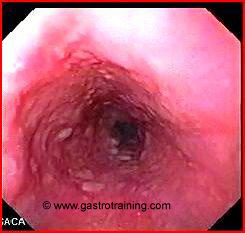Mr Jacob, a 60 year old painter complained of chronic abdominal pain. Endoscopy showed

What is the diagnosis?
Discuss the endoscopic features of glycogenic acanthosis?
These lesions appear as multiple uniformly sized oval or round grey-white plaques usually 2-10 mm in diameter. They may form a confluent conglomeration with a cobblestone mucosal pattern. Although they may involve any oesophageal segment, these nodules are most common in the distal third.
What is the aetiology?
It is characterized by multifocal plaques of hyperplastic squamous epithelium with abundant intracellular glycogen deposits. The aetiology is unknown.
Because glycogenic acanthosis appear in the fifth to sixth decades of life and become more numerous and larger with increasing age, the condition is thought to be an age-related, degenerative process
Discuss the clinical features?
These nodules or plaques result from accumulation of excess glycogen in mature squamous cells of the upper epithelium.
This condition is asymptomatic and an incidental finding. Many endoscopists regard it as normal variation
The prevalence of it varies from 5% to 15% in endoscopic series. The incidence increases with age without gender predilection.
Image courtesy of www.gastrointestinalatlas.com







